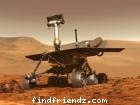
[ Join This Club ]
Exploring Mars
By : karishma111 |
Members :7
Location : mumbai , India
Type : Public
Created on :
17 Dec 2012
Last Updated on :
17 Dec 2012 |
|
Findfriendz / Clubs / Science and History / Exploring Mars
Exploring Mars
THE flying-saucer-shaped probe hurtles through space, firing thrusters and flinging off weights to point its heat shield forwards for the scorching trip through Mars’s atmosphere. Once it has slowed, the heat shield drops away and, 10 kilometres above the surface, a parachute billows out. More weights are jettisoned, pointing the craft’s radar-tipped belly towards the fast-approaching ground.
The probe cuts loose its parachute and upper shell, then fires thrusters towards the ground, slowing its speed further to 3 kilometres per hour. Hovering 20 metres above the Martian surface, the probe starts to unspool an SUV-sized rover from its belly. Dangling on cables like a giant spider, the payload is gently lowered by a "sky crane" to the surface. Curiosity has landed.
So begins a slick animation of NASA’s newest rover, which is due to blast off on 25 November. The manoeuvres are so precise in their choreography and timing that their successful implementation seems improbable - especially given that Mars is the Bermuda Triangle of the solar system, dooming to failure two-thirds of the missions that attempt to visit it. "Everything has to behave according to plan," admits mission leader John Grotzinger of the California Institute of Technology in Pasadena.
The stakes could barely be higher. The $2.5 billion rover will be the most ambitious and expensive mission ever sent to Mars, carrying state-of-the-art tools that will reveal whether its landing site was ever habitable and search for signs of life preserved in its rocks. The first rover to be powered by the radioactive decay of plutonium rather than sunlight, Curiosity will be able to work around-the-clock and through the Martian winter.
"It’s going to be a huge step forward," says Steve Squyres at Cornell University in Ithaca, New York, lead scientist for the Mars Exploration Rovers Spirit and Opportunity, which landed on different sides of the planet in 2004.
But first Curiosity has to touch down safely. "Anytime you land on Mars, it’s a slightly scary thing," says Squyres. Both Spirit and Opportunity were swaddled in airbags and bounced to a landing, but Curiosity weighs five times as much and would simply punch through airbags as if they weren’t there. "We pushed the airbag technology about as far as you could push it," says Squyres. "The sky crane system is a good engineering solution to the problem." More

|
Club Members[7]
|








